Algae: Chlorophyceae, Phaeophyceae & Rhodophyceae | Biology Class 11 - NEET PDF Download
| Table of contents |

|
| Chlorophyceae (Green Algae) |

|
| Phaeophyceae (Brown Algae) |

|
| Rhodophyceae (Red Algae) |

|
| Frequently Asked Questions (FAQs) |

|
| Old NCERT |

|
Algae, the diverse group of photosynthetic organisms, are more than just slimy green plants found in ponds and lakes. They are of paramount importance in a variety of ways and play a significant role in our lives. In fact, at least half of the earth's total carbon dioxide fixation is carried out by algae through photosynthesis, making them one of the primary contributors to the balance of oxygen and carbon dioxide in our atmosphere.
The algae are divided into three main classes: Chlorophyceae, Phaeophyceae and Rhodophyceae.

Chlorophyceae (Green Algae)
Green algae, also known as Chlorophyceae, are a diverse group of photosynthetic organisms. These organisms have a unique plant body, which can be either unicellular, colonial, or filamentous. One of the key characteristics of green algae is the presence of two dominant pigments, chlorophyll a and b, that give it a grass green color.
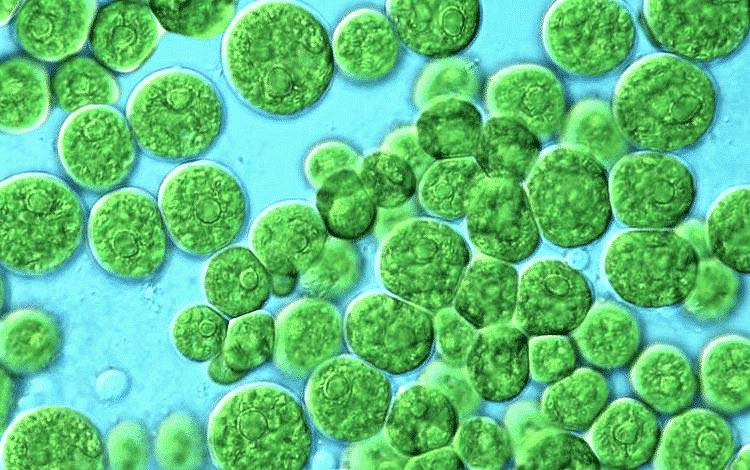
(a) Morphology and Pigments
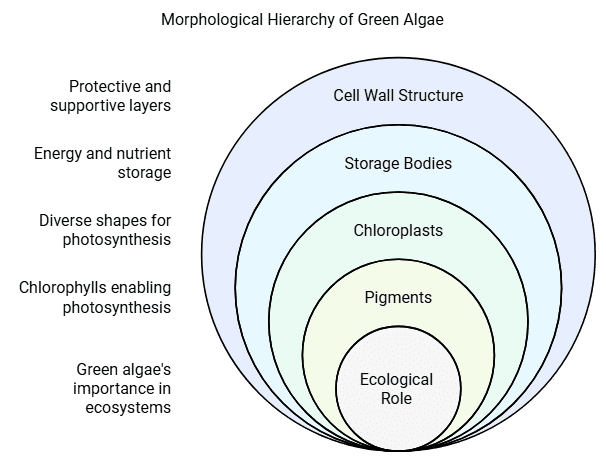
- The morphology of green algae is quite diverse, and their cell structures vary widely depending on the species.
- Chloroplasts, the organelles responsible for photosynthesis, are a key feature of green algae, and they come in various shapes and sizes, including discoid, plate-like, reticulate, cup-shaped, spiral or ribbon-shaped.
- In addition to chloroplasts, green algae have different types of storage bodies such as pyrenoids and oil droplets, which they use to store energy and nutrients.
- Furthermore, green algae have a rigid cell wall made of an inner layer of cellulose and an outer layer of pectose, which provides structural support and protection to the cells.
- These unique morphological features and the presence of pigments such as chlorophyll a and b enable green algae to play a vital role in the environment, making them important for a variety of applications, including food production, water treatment, and biofuel production.
(b) Chloroplasts and Pyrenoids
- Chloroplasts are organelles found in plant cells that are responsible for photosynthesis, the process by which plants convert sunlight into energy.
- Green algae, a group of algae that contain chlorophyll a and b, also have chloroplasts. Chloroplasts contain pigments that capture sunlight and use it to produce energy.
- In addition, some green algae may have one or more pyrenoids in their chloroplasts. Pyrenoids are structures that contain protein and starch and are involved in carbon dioxide fixation and the storage of carbohydrates.

- Pyrenoids are particularly important for green algae because they allow them to store and use energy efficiently.
- Together, chloroplasts and pyrenoids enable green algae to produce energy, grow, and thrive in a variety of environments, making them essential for many aspects of life on Earth.
(c) Cell Wall
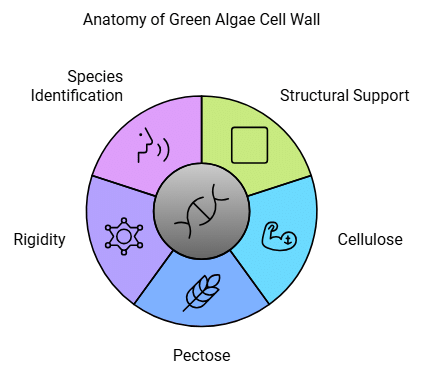
- The cell wall is a crucial component of plant and algal cells, providing structural support and protection against environmental stressors.
- In green algae, the cell wall is rigid and is composed of cellulose and pectose.
- Cellulose, a type of carbohydrate, is the primary component of the cell wall and gives it its strength and rigidity.
- Pectose, another type of carbohydrate, is found in the outer layer of the cell wall and helps to bind the cellulose fibers together, making the cell wall even stronger.
- The rigidity of the cell wall is an important feature of green algae, allowing them to maintain their shape and protect their internal structures.
- Additionally, the composition of the cell wall is an essential characteristic for identifying and classifying different species of green algae.
(d) Reproduction
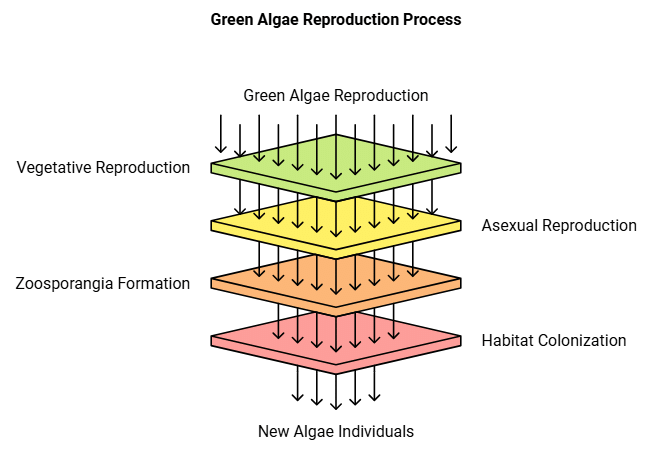
- Green algae reproduce through both vegetative and asexual means.
- Vegetative reproduction occurs through fragmentation or the formation of spores. In fragmentation, a piece of the parent algae breaks off and grows into a new individual. Spores, on the other hand, are single cells that are capable of developing into a new organism.
- Green algae can produce a variety of different types of spores, each with its unique characteristics and method of dispersal.
- Asexual reproduction, which does not involve the fusion of gametes, is also prevalent in green algae. This type of reproduction occurs through the production of flagellated zoospores. These are produced in specialized structures called zoosporangia and are capable of swimming through water using their flagella. Once they reach a suitable environment, they settle and grow into new individuals.
- Asexual reproduction in green algae allows for rapid population growth and the colonization of new habitats.
Overall, the ability to reproduce through both vegetative and asexual means allows green algae to thrive in a variety of environments and maintain healthy populations.
(e) Types of Sexual Reproduction
Green algae can reproduce sexually through different mechanisms, depending on the species.

- Isogamous reproduction involves the fusion of two identical gametes, which are usually motile and look alike. In contrast, anisogamous reproduction involves the fusion of two gametes of different sizes, with one gamete being larger than the other. The larger gamete is usually immobile and serves as the female, while the smaller gamete is motile and serves as the male.
- Oogamous reproduction is the most common form of sexual reproduction in green algae. It involves the fusion of one large, non-motile female gamete with one or more small, motile male gametes. The female gamete, known as the egg, is retained within the parent organism and fertilized by the male gamete(s). This type of reproduction allows for genetic diversity and the production of offspring with different traits.
Commonly Found Green Algae: Chlamydomonas, Volvox, Ulothrix, Spirogyra, and Chara.
Phaeophyceae (Brown Algae)
Also known as Brown algae or kelps or Seaweeds

- Brown algae are found in marine water.
- Brown algae are multicellular filamentous.
- Brown algae are the largest in size (upto 60 meters in length).
- Largest brown algae – Macrocystis
- Thallus of brown algae is divided into two parts:
(i) Lamina - Leafy part or photosynthetic part.
(ii) Stipe - Elongated tubes called trumpet hyphae are present for food conduction in stipe. Trumpet hyphae are analogous to sieve tubes of vascular plants. Due to lamina and stipe, brown algae look like leaf (leafy algae).
Example: Fucus, Dictyota, Ectocarpus
(a) Pigments

- Chlorophyll - Chl 'a', Chl 'c'
- Carotene - Only b carotene
- Xanthophylls - Mainly Fucoxanthin
 View Answer
View Answer 
Note: The amount of Fucoxanthin is more in brown algae due to which these algae are brown in colour. (Xanthophylls are mostly yellow but fucoxanthin is brown)
- Stored food: Laminarin and mannitol - both are derivatives of carbohydrates.
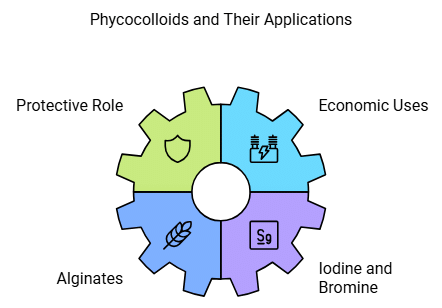
(b) Phycocolloids
- On cell wall of brown algae some colloid substances like fucinic acid, alginic acid and fucoidin are present which are known as phycocolloids.
- Phycocolloids protect brown-algae against dessication and shocks. Phycocolloids are used in ice-cream as thickening agent. Alginates, salts of alginic acid used for dentury measurement.
 View Answer
View Answer 
Special Point: Life cycle of Ectocarpus and kelps are diplohaplontic, life cycle of Fucus is diplontic.
(c) Economic Importance
- Alginates or Alginic acid: Obtained from Laminaria, Fucus, Macrocystis.
- Alginates are used in the manufacturing of soap, ice-cream, polish, cream and plastic.
- Iodine and Bromine: Obtained from Laminaria.
Rhodophyceae (Red Algae)
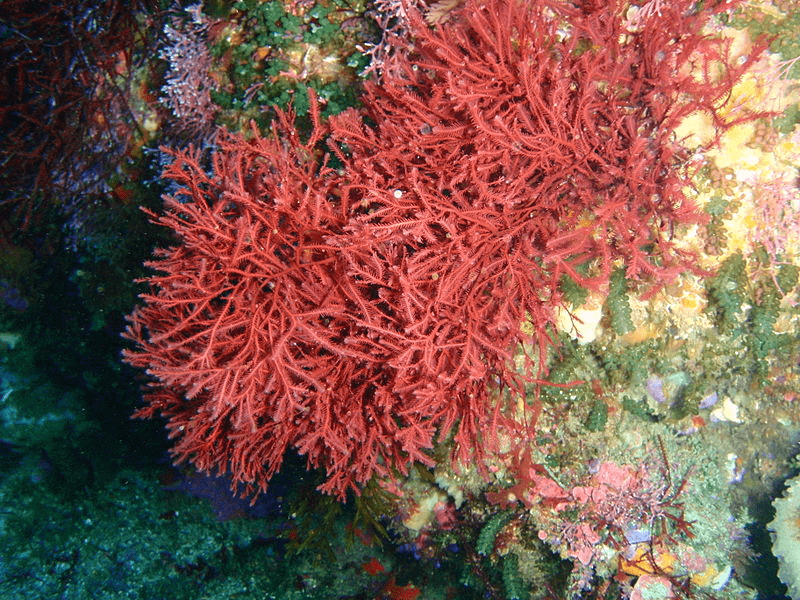
- Red algae are second most ancient algae after blue-green algae i.e. they are developed after blue-green algae.
Example: Polysiphonia - Red algae mainly found in marine water. But exceptionally Batrachospermum is found in fresh water (river) and Porphyridium is found on land.
- Red algae are multi-cellular but exceptionally Porphyridium is unicellular.
- There is no motile stage found in life cycle of red algae and BGA i.e. cilia & flagella are absent.
- Cell wall of red algae is complex and made up of cellulose & pectin.
- The cell wall of red algae is also complicated like blue-green algae. Their cell wall has many different type of substances such as xylan, galactose, polyuronic acid, polysulphate esters.
- But in some algae, calcium carbonate is also present in the cell wall, due to which their thallus become stony.
- These algae form limestone & coral reefs.
Example: Corallina and Lithothamnion.
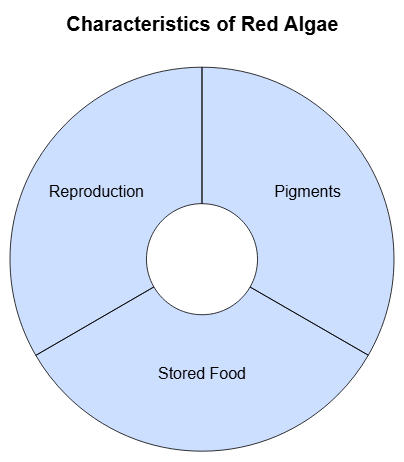
(a) Pigments
- Chlorophyll - Chl 'a' and Chl 'd'
- Carotenes - b
- Phycobilins - R - phycoerythrin (red coloured) and R - phycocyanin (blue coloured)
- On the basis of pigments red algae is similar to blue green algae.
- Colour of red algae changes according to depth in sea. This is called as Gaudikov's effect.
- When red algae are present on the surface of the sea, then their colour is blue and when they are at the bottom, their colour is red. At the surface of sea the amount of R - phycocyanin is more while in depth the amount of R - phycoerythrin is more.
- Penetration power is maximum in ultraviolet and violet light. R-phycoerythrin is only pigment to absorb ultraviolet and violet light. Due to phycoerythrin red algae are deepest algae.
- Gaudikov's effect is also found in Blue-Green algae.
- Red algae are not always red, it may be blue coloured also.
Example: Batrachospermum (This is a blue coloured algae)
(b) Stored Food
- Floridean starch: It is a primitive type of starch. Structurally floridean starch is similar to the cyanophycean starch of blue green algae. Starch of higher plants is less branched yet floridean starch & cyanophycean starch is highly branched.
- Glycogen is also highly branched so that floridean & cyanophycean starch is structurally similar to glycogen and amylopectin.
- Phycocolloids: Agar -Agar, carrageenin and funori phycocolloids are found in the cell wall of red algae.
(c) Reproduction
1. Vegetative: By fragmentation
2. Asexual: Non motile spores [By monospore, carpospores, tetraspore]
3. Sexual reproduction
- Sexual reproduction is oogamous type.
- The female sex organs are called carpogonia. They are apparently similar to archegonia of bryophyta. Carpogonia is unicellular & jacketless but archegonia is multicellular & jacketed.
- The male sex organs of red algae are known as spermatangia. Non motile spore like gametes are formed in spermatangia which are known as spermatia.
- Life cycle of Polysiphonia is diplobiontic and Batrachospermum is haplobiontic.
Divisions of Algae and their Main Characteristics
Frequently Asked Questions (FAQs)
Q. What are green algae?
Green algae are a diverse group of photosynthetic organisms with a unique plant body that can be unicellular, colonial, or filamentous. They are characterized by the presence of two dominant pigments, chlorophyll a and b, which give them a grass-green color. Green algae have chloroplasts that come in various shapes and sizes, different types of storage bodies, and a rigid cell wall made of cellulose and pectose. Green algae reproduce through both vegetative and asexual means, and sexually through different mechanisms such as isogamous, anisogamous, and oogamous reproduction.
Q. What is the importance of chloroplasts and pyrenoids in green algae?
Chloroplasts are organelles found in plant and algal cells that are responsible for photosynthesis. Green algae have chloroplasts containing pigments that capture sunlight and use it to produce energy. In addition, some green algae may have one or more pyrenoids in their chloroplasts. Pyrenoids are structures that contain protein and starch and are involved in carbon dioxide fixation and the storage of carbohydrates. Pyrenoids allow green algae to store and use energy efficiently, enabling them to produce energy, grow, and thrive in a variety of environments.
Q. What is phaeophyceae or brown algae?
Phaeophyceae or brown algae are a group of marine algae that vary greatly in size and form, ranging from simple branched, filamentous forms to profusely branched forms that may reach a height of 100 meters. They possess chlorophyll a, c, carotenoids and xanthophylls and vary in color from olive green to various shades of brown depending upon the amount of the xanthophyll pigment, fucoxanthin present in them.
Q. How is food stored in brown algae?
Food is stored as complex carbohydrates, which may be in the form of laminarin or mannitol.
Q. How is the plant body of brown algae attached to the substratum?
The plant body is usually attached to the substratum by a holdfast, and has a stalk, the stipe and leaf-like photosynthetic organ – the frond.
Q. What are the types of sexual reproduction in brown algae?
Sexual reproduction may be isogamous, anisogamous, or oogamous. Union of gametes may take place in water or within the oogonium (oogamous species). The gametes are pyriform (pear-shaped) and bear two laterally attached flagella.
Q. What is the pigment that gives red algae their color?
The predominant pigment in red algae is r-phycoerythrin, which gives them their red color.
Q. What is the food storage structure in red algae?
The food in red algae is stored as floridean starch, which is very similar in structure to amylopectin and glycogen.
Old NCERT
Phaeophyceae (Brown Algae)
Special name:
- Postelsia: It is known as Sea palm.
- Ancyclonema: It is called Ice bloom because it grows on marine ice.
- Sargassum: It is known as Gulf weed because Sargassum is a free-floating alga. It grows rapidly in North Atlantic ocean and covers thousands of hectares of area. Therefore this region is called as sargasso sea.
- Laminaria (Kelps): It is called as Devil's Aprin.
Rhodophyceae (Red Algae)
Special Points and Economic Importance
- Harveyella: It is a colourless parasitic alga. It remains as parasite on other alga.
- Porphyra: It is an edible algae.
- Gelidium and Gracilaria: Agar - Agar colloid is obtained from these. It is used to prepare culture medium.
- Chondrus crispus: It is also called Irish moss. Carrageenin colloid is obtained from this alga. It is used as gelating agent in food industries (i.e. to make the food item viscous). Capsule of medicines is also prepared from carrageenin.
- Haematococcus nivalis (Red snow): It likes to grow on snow and imparts red colour to snow.
Habitat of Some Important Algae
- Terrestrial: The algae found in moist soil & wall.
Example: Terrentofolia - Epiphytes: Algae that are present on plants.
Example: Protococcus - Endophytes: Algae that are present inside plants.
Example: Coleochaete nitelum (in Nitella plant) - Epizoic: Algae that are present on animals.
Example: Cladophora (present on Mollusca shell) - Endozoic: Algae that are present inside the body of animals.
Example: Zoochlorella and Zooxenthellae (inside the Hydra) - Parasites: Algae that live as parasite and causes diseases.
Example: Cephaleuros (algae remains in the leaves of tea plant) Cephaleuros causes red rust disease of tea. - Thermophilic: Algae found in hot water.
Example: Chlorella - Cryophytes: Algae which are present in polar regions & Low Temperature.
Example: Chlamydomonas (some species), Haematococcus nivalis (It develops red snow in polar region.) - Epiphloephytes: Algae arise on bark of trees
|
150 videos|399 docs|136 tests
|
FAQs on Algae: Chlorophyceae, Phaeophyceae & Rhodophyceae - Biology Class 11 - NEET
| 1. What are the main characteristics of Chlorophyceae (Green Algae)? |  |
| 2. How do Phaeophyceae (Brown Algae) differ from other algae groups? |  |
| 3. What are the economic uses of Rhodophyceae (Red Algae)? |  |
| 4. What environmental conditions favor the growth of Chlorophyceae, Phaeophyceae, and Rhodophyceae? |  |
| 5. What roles do algae like Chlorophyceae, Phaeophyceae, and Rhodophyceae play in aquatic ecosystems? |  |
















